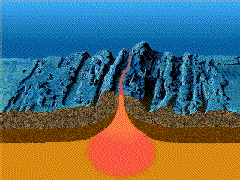Mid-ocean ridge
Mid-ocean ridges are underwater mountain ranges, formed by plate tectonics. These ridges are characterized by a rift at the summit, where magma from beneath the Earth's crust rises, cools, and solidifies to form new oceanic crust. This process, known as seafloor spreading, occurs at divergent plate boundaries where tectonic plates move apart from each other.
Formation and Structure[edit | edit source]
Mid-ocean ridges are the result of mantle convection beneath the Earth's crust. As hot mantle material rises towards the surface at a divergent boundary, it decreases in pressure, melts, and forms magma. This magma then rises through the cracks in the Earth's crust, erupting as lava and solidifying to form new crust. The continuous addition of new material from below pushes the older crust away from the ridge, creating a pattern of symmetrical seafloor spreading on either side of the ridge.
The structure of a mid-ocean ridge includes the central rift valley, flanked by parallel mountain chains. The rift valley is the deepest part of the ridge, where the seafloor is actively spreading apart. The elevation of the ridge compared to the surrounding ocean floor is due to the buoyancy of the warmer, less dense newly formed crust.
Global Distribution[edit | edit source]
Mid-ocean ridges span about 65,000 kilometers (40,000 miles) across the Earth's oceans, making them the longest mountain range in the world. The most prominent is the Mid-Atlantic Ridge, which extends from the Arctic Ocean to the southern tip of Africa. Other notable mid-ocean ridges include the East Pacific Rise and the Indian Ocean Ridge.
Ecology[edit | edit source]
The unique environment of mid-ocean ridges supports diverse ecosystems. Hydrothermal vents, found near ridges, eject mineral-rich water that sustains communities of organisms adapted to extreme conditions. These ecosystems are notable for their lack of sunlight, relying instead on chemosynthesis for energy production.
Exploration and Research[edit | edit source]
Mid-ocean ridges have been a focus of oceanographic research since their discovery. They are key sites for studying plate tectonics, volcanism, and deep-sea ecology. Research is conducted using submersibles, remotely operated vehicles (ROVs), and seafloor observatories.
Economic and Environmental Significance[edit | edit source]
Mid-ocean ridges play a role in the Earth's geological cycle, influencing the chemistry of the ocean and the atmosphere. They are also of interest for mining due to their rich deposits of minerals and rare earth elements. However, mining activities pose potential threats to the fragile deep-sea ecosystems.
See Also[edit | edit source]
Search WikiMD
Ad.Tired of being Overweight? Try W8MD's physician weight loss program.
Semaglutide (Ozempic / Wegovy and Tirzepatide (Mounjaro / Zepbound) available.
Advertise on WikiMD
|
WikiMD's Wellness Encyclopedia |
| Let Food Be Thy Medicine Medicine Thy Food - Hippocrates |
Translate this page: - East Asian
中文,
日本,
한국어,
South Asian
हिन्दी,
தமிழ்,
తెలుగు,
Urdu,
ಕನ್ನಡ,
Southeast Asian
Indonesian,
Vietnamese,
Thai,
မြန်မာဘာသာ,
বাংলা
European
español,
Deutsch,
français,
Greek,
português do Brasil,
polski,
română,
русский,
Nederlands,
norsk,
svenska,
suomi,
Italian
Middle Eastern & African
عربى,
Turkish,
Persian,
Hebrew,
Afrikaans,
isiZulu,
Kiswahili,
Other
Bulgarian,
Hungarian,
Czech,
Swedish,
മലയാളം,
मराठी,
ਪੰਜਾਬੀ,
ગુજરાતી,
Portuguese,
Ukrainian
Medical Disclaimer: WikiMD is not a substitute for professional medical advice. The information on WikiMD is provided as an information resource only, may be incorrect, outdated or misleading, and is not to be used or relied on for any diagnostic or treatment purposes. Please consult your health care provider before making any healthcare decisions or for guidance about a specific medical condition. WikiMD expressly disclaims responsibility, and shall have no liability, for any damages, loss, injury, or liability whatsoever suffered as a result of your reliance on the information contained in this site. By visiting this site you agree to the foregoing terms and conditions, which may from time to time be changed or supplemented by WikiMD. If you do not agree to the foregoing terms and conditions, you should not enter or use this site. See full disclaimer.
Credits:Most images are courtesy of Wikimedia commons, and templates, categories Wikipedia, licensed under CC BY SA or similar.
Contributors: Prab R. Tumpati, MD





